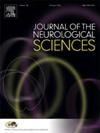Longitudinal evolution of diffusion metrices within the Cerebello-Thalamo-cortical tract after MRgFUS thalamotomy for essential tremor
IF 3.2
3区 医学
Q1 CLINICAL NEUROLOGY
引用次数: 0
Abstract
Magnetic resonance-guided focused ultrasound (MRgFUS) thalamotomy in essential tremor (ET) targets ventral intermediate nucleus hub region within cerebello-thalamo-cortical tract (CTCT). Understanding the microstructural changes in CTCT over time and their link to tremor improvement is crucial from a tremor-network perspective. We retrospectively analyzed tremor scores, lesion characteristics, and diffusion MRI-derived CTCT microstructural measures in 27 ET patient's pre-treatment (T0), at 1 month (T2), and 6 months (T3) post-MRgFUS. Using probabilistic tractography, we created an average CTCT mask at T0 for assessing fractional anisotropy (FA), axial (AD), mean (MD), and radial diffusivity (RD) measures across time points. Significant tremor reduction was observed at T2 and T3. The Linear mixed effect analyses showed significant time effects for FA, MD, and AD. Relative to baseline, post-hoc comparisons showed a significant decrease of FA and AD at lesion site only for T2. Instead, there was a significant increase in AD and MD at T3 compared to T2 at lesion site, and remotely near the motor cortex. Lesion size and FA changes in the CTCT at T2 showed only trend-level correlations with tremor outcome. Stronger associations were observed for the thalamic lesion-tract overlap at T2, which were even more robust at T3. Dynamic microstructural changes suggest early axonal disruption at the lesion site and subsequent reorganization, with remote CTCT changes potentially indicating chronic degeneration. Meanwhile, microstructural measures show limited predictive value for tremor outcome at 6 months compared with macroanatomical lesion-CTCT overlap. Yet, advanced diffusion imaging protocol could increase the sensitivity to predict MRgFUS clinical outcome.
特发性震颤的MRgFUS丘脑切开术后小脑-丘脑-皮质束内扩散测量的纵向演变
磁共振引导的聚焦超声(MRgFUS)在特发性震颤(ET)治疗中靶向小脑-丘脑-皮质束(CTCT)的腹侧中间核中枢区。从震颤网络的角度来看,了解CTCT随时间的微观结构变化及其与震颤改善的联系是至关重要的。我们回顾性分析27例ET患者治疗前(T0)、mrgfus后1个月(T2)和6个月(T3)的震颤评分、病变特征和弥散性mri衍生的CTCT显微结构测量。使用概率神经束造影,我们在T0创建了一个平均CTCT掩模,用于评估各时间点的分数各向异性(FA)、轴向(AD)、平均(MD)和径向扩散率(RD)。在T2和T3时观察到明显的震颤减轻。线性混合效应分析显示FA、MD和AD的时间效应显著。相对于基线,事后比较显示仅T2病变部位FA和AD显著降低。相反,与T2相比,病变部位和远离运动皮质的T3时AD和MD明显增加。T2时CTCT的病变大小和FA变化与震颤结果仅呈趋势水平相关。在T2时观察到更强的丘脑病变束重叠,在T3时甚至更强。动态显微结构变化提示病变部位的早期轴突破坏和随后的重组,远程CTCT变化可能提示慢性变性。同时,与宏观解剖病变- ctct重叠相比,微观结构测量对6个月震颤结局的预测价值有限。然而,先进的扩散成像方案可以提高预测MRgFUS临床结果的敏感性。
本文章由计算机程序翻译,如有差异,请以英文原文为准。
求助全文
约1分钟内获得全文
求助全文
来源期刊

Journal of the Neurological Sciences
医学-临床神经学
CiteScore
7.60
自引率
2.30%
发文量
313
审稿时长
22 days
期刊介绍:
The Journal of the Neurological Sciences provides a medium for the prompt publication of original articles in neurology and neuroscience from around the world. JNS places special emphasis on articles that: 1) provide guidance to clinicians around the world (Best Practices, Global Neurology); 2) report cutting-edge science related to neurology (Basic and Translational Sciences); 3) educate readers about relevant and practical clinical outcomes in neurology (Outcomes Research); and 4) summarize or editorialize the current state of the literature (Reviews, Commentaries, and Editorials).
JNS accepts most types of manuscripts for consideration including original research papers, short communications, reviews, book reviews, letters to the Editor, opinions and editorials. Topics considered will be from neurology-related fields that are of interest to practicing physicians around the world. Examples include neuromuscular diseases, demyelination, atrophies, dementia, neoplasms, infections, epilepsies, disturbances of consciousness, stroke and cerebral circulation, growth and development, plasticity and intermediary metabolism.
 求助内容:
求助内容: 应助结果提醒方式:
应助结果提醒方式:


